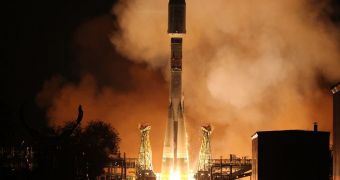After undergoing a long period of preparation and testing, the European Space Agency's (ESA) MetOp-B weather satellite was launched into space on Monday, September 17, from the Baikonur Cosmodrome, in Kazakhstan.
The spacecraft was carried to orbit aboard a Soyuz-Fregat delivery system, which was provided under an agreement ESA signed with the Russian Federal Space Agency (RosCosmos) a while back.
As its name implies, MetOp-B is the second spacecraft of the MetOp series to launch into orbit, following MetOp-A, in 2006. Currently, the latter is operating in an extended mission phase, having long since completed its primary science mission.
These weather satellites are placed on polar orbits, meaning that they fly over both poles, rather than spin around the Equator. This is the same type of orbit occupied by surveillance and spy satellites.
MetOp-B took off at around 16:28 GMT, and managed to reach its 810-kilometer (503.3-mile) polar orbit less than 70 minutes later. As this happened, it was flying over the Kerguelen Archipelago, in the Indian Ocean.
As soon as this milestone was reached, spacecraft control was taken over by the ESA European Space Operations Center (ESOC), in Darmstadt, Germany. After orbital testing, MetOp-B controls will be handed over to the European Organization for the Exploitation of Meteorological Satellites (EUMETSAT).
“The launch of this second Metop satellite has taken place about two and a half months after that of MSG-3; this is a perfect illustration of the vitality of Europe’s weather satellite programs developed in cooperation between ESA and EUMETSAT,” ESA Director General Jean-Jacques Dordain says.
“The fact that the next generation satellites in line are already being prepared by ESA shows the strong commitment of Member States of both organizations to continue and improve collecting data that are supporting not only weather-forecasting but also monitoring and understanding of climate change,” he adds.
“Such services are demonstrating daily the economical and societal value of investing in space infrastructure,” the top ESA official explains. He says that one of the most important aspects of the new launch is that it ensures continuity between MetOp-A and MetOp-B datasets.

 14 DAY TRIAL //
14 DAY TRIAL //